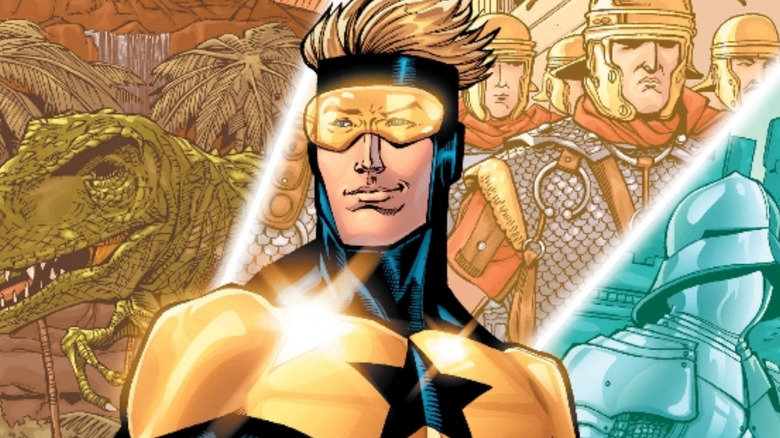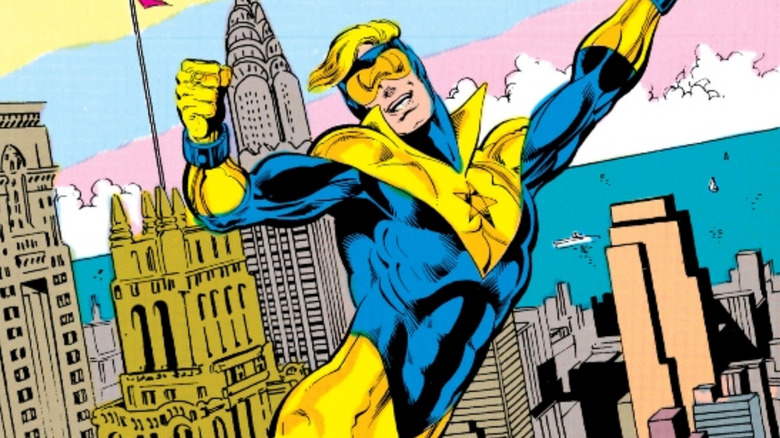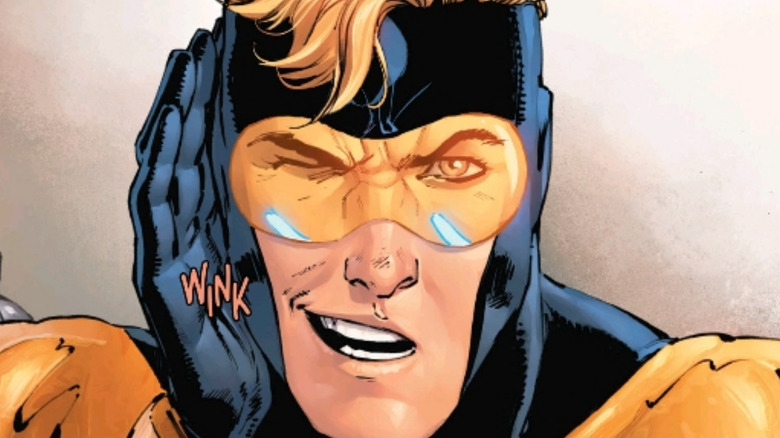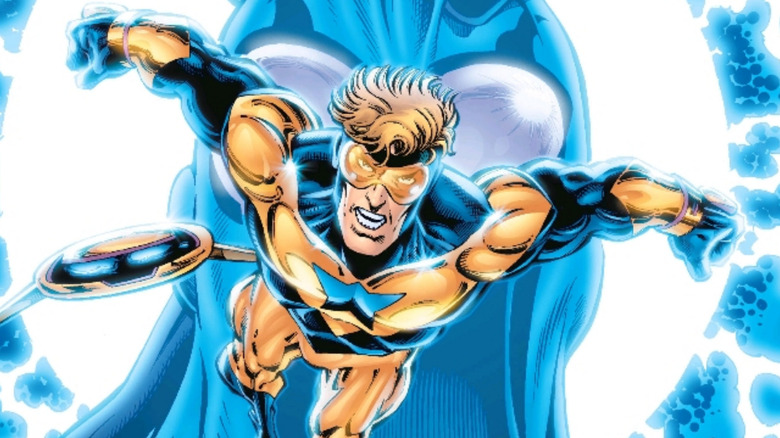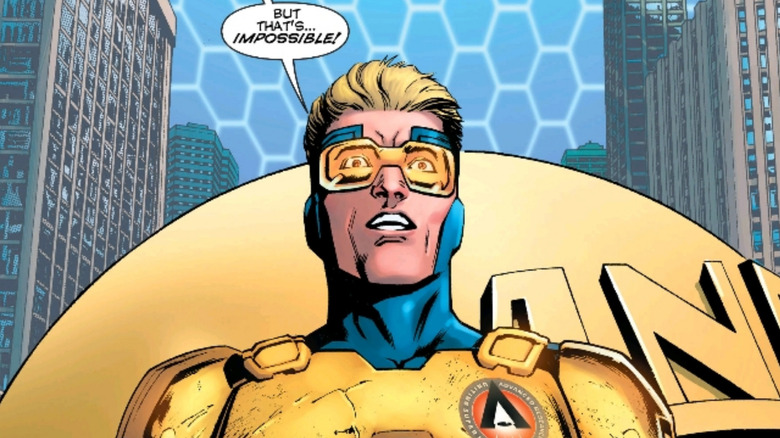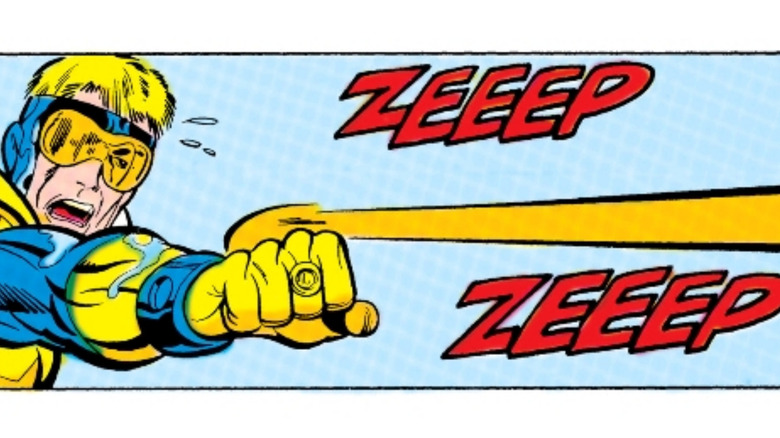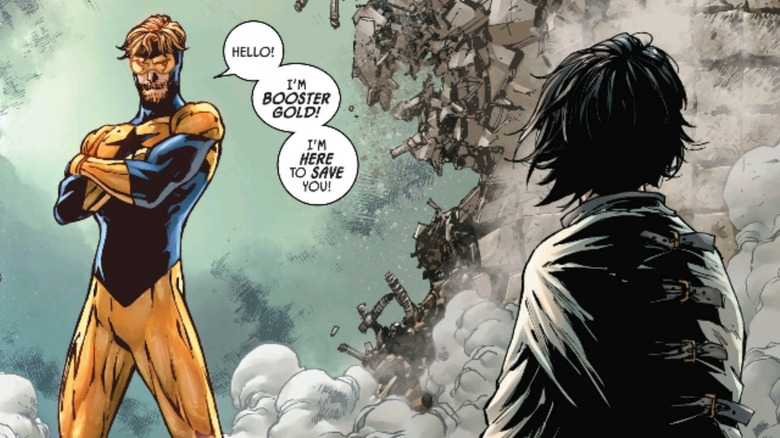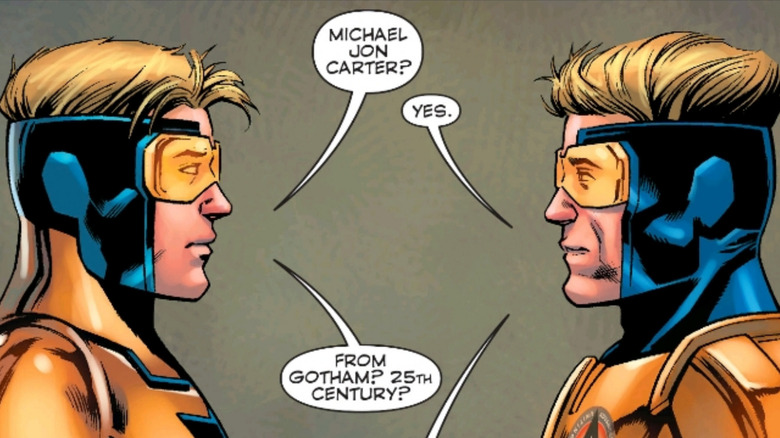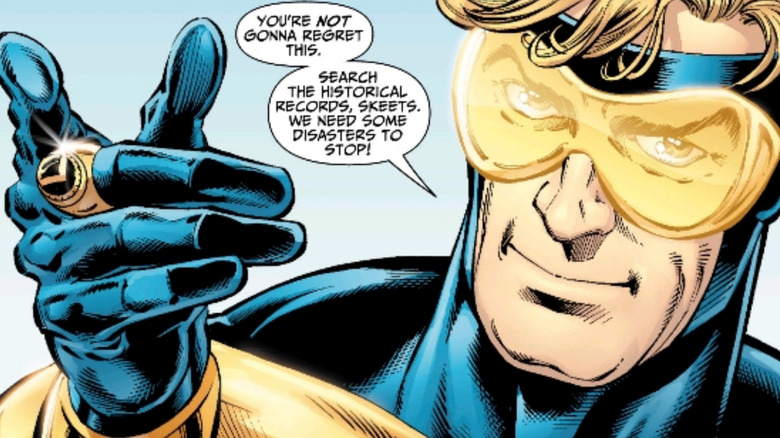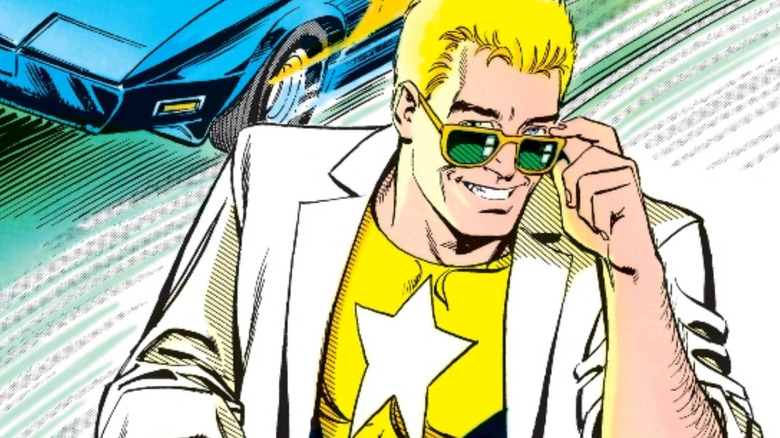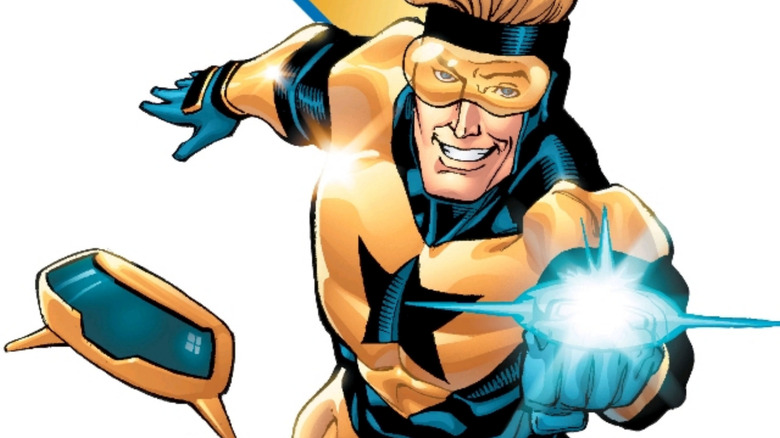Booster Gold's Powers And Abilities Explained
Creator Dan Jurgens is a comic book legend, and he's worked on a seemingly endless list of some of Marvel and DC's best and brightest over the decades. Yet, one of his greatest contributions to comics has to be Booster Gold, a time-traveling hero who taps his knowledge of the past to create opportunities for himself to grandstand in hopes of becoming the greatest hero of our era. That description might make Booster come off as a little bit morally questionable (he definitely is) but underneath all the bravado, there's ... even more bravado, and then under that, there's a heart of, well, gold. A card-carrying Justice League member and best friend to the occasional Blue Beetle Ted Kord, Booster has had time to show us that, when he really wants to be, he is genuinely a good guy and an effective hero.
Recently announced as the star of his own series in James Gunn's reboot of the DC cinematic universe, Booster Gold is about to see his celebrity status rise like never before. A time traveler from the 25th century with loosely defined morality interacting with the rest of the often-epically heroic DC Universe is the kind of premise that writes itself, but outside of a few tantalizing details, we don't know much about what this series might entail. What we do know is Booster Gold's history, and his wacky set of powers. Cobbled together via ethically ambiguous means in a future far, far away, Booster's powers and abilities are a big part of what makes him such an interesting guy.
Flight Ring
One of Booster's most regularly used abilities is that of flight, which he achieves with his handy dandy Legion Flight Ring direct from the futuristic Legion of Super-Heroes from the 30th century. Of course, Booster was never in the Legion – there's about a five-century difference in their timelines, after all – so how does that check out? Fortunately, this is all explained (if a bit confusingly) in the original "Booster Gold" series from 1986. In issues #8 and #9, we enjoy a flashback tale that delves into Booster's initial appearance in the 20th century, which also explains some of his powers and motivations, and how Skeets helps him figure things out even in the early days of his superheroics.
The mysterious one-off villain Chiller is working in service of the Metropolis supervillain group called the 1000, and he uses his powers of metamorphosis to attempt to orchestrate a political takeover by imitating then-President Ronald Reagan. Hoping to announce a senator named Ballard as vice president, resign due to "ill health," and thereby appoint Ballard to the presidency, this nefarious scheme is thwarted by Booster and Legion members Chameleon Boy, Brainiac 5, and Ultra Boy. After putting a stop to this potentially catastrophic attempt at a coup, Brainiac 5 leaves a well-placed Legion Flight Ring behind for Booster to pick up in the distant future. (How Brainiac 5 could've known this ring eventually ends up in the Metropolis Space Museum where Booster finds all his equipment is just one of many unanswerable questions presented by DC's infamously slippery timeline.) Booster Gold's backstory is full of fun facts like this, even if you have to dig through the archives a bit to find them.
Enhanced senses
Among Booster's many assets, some of his most overlooked are the abilities granted to him by his visor. Beyond looking pretty awesome, the sheer yellow shield over his eyes grants him a number of important skills, including enhanced vision. Not only does he see better and farther due to the visor, but he can zoom in on objects, scan the electromagnetic spectrum, tap into X-ray vision, and see in both infrared and ultraviolet. Besides that, the visor helps his hearing, and while this doesn't place him on the level of Superman's improved sensory reception, it proves immensely helpful when Booster needs to engage in the rare moment of subterfuge.
Yet, perhaps one of the most important and underutilized features of the visor is its built-in heads-up display (HUD), which helps Booster with targeting his energy blasts as well as serving as a sort of tech version of Peter Parker's Spidey-Sense. Booster isn't always the most spatially aware of the superheroes, and having a piece of tech that works to warn him of impending threats that he otherwise might never notice has proven to be a vital asset in his travels across the multiverse. The visor is a neat tool that is seldom delved into fully, making it a key example of a part of Booster's power set that would benefit greatly from a little further exploration in the upcoming series.
Force field and intangibility
It's rare that we see Booster tap into the intangibility granted by his suit, which is more regularly used for time travel and creating pockets in time that protect him from chronal disorientation. However, it is one of his most interesting abilities, even if it has remained mostly underused. It might not surprise you to hear that Booster is the kind of guy that supervillains love to throw a punch at, and intangibility can help him avoid being smashed to smithereens when a particularly unscrupulous fighter targets him. However, the gadgets much more commonly used in this regard are his forced fields, which he utilizes in most of his fights, as well as during time jumps.
The force fields come from Booster's belt, and while not all his redesigns feature this accessory, the ability remains worked into his suit regardless. Featuring enough power to ward off most attacks short of an atom bomb, the fields have saved Booster's life more times than anyone could count by now. They also enable him to throw himself into the act of protecting others with the full knowledge that his body can serve as a barrier between civilians and attacks from supervillains.
Strength and durability
Most superheroes have heightened strength and durability, which allows them to survive things like interplanetary travel and regular knocks to the head that would otherwise leave a person concussed beyond all belief. While Booster's many other bits of tech — force fields, energy blasters, etc. — certainly curb the physical damage he might take on in a fight, his suit grants him an added layer of superhuman strength and built-in stamina. It's hard to gauge this in measurement, but Booster has gone toe-to-toe with a lot of major villains and lived to tell the tale.
The power system behind Booster's suit has changed over time, but initially, it was supplied by power rods from the future that could not be recharged in our timeline, which forces Booster to engage with his own limitations fairly regularly. However, even in the early days, Booster's costume has always been lightweight, despite granting him the ability to lift at least 20 tons without straining himself or the suit. Likewise, even without the force field that, at one point, survives a punch from Doomsday (even if just barely), the suit allows him to withstand being shot repeatedly, though the experience remains just as unpleasant as one might imagine, even if bullets can't breach his suit on their own.
Energy blasts
As a superhero regularly thrown into the fray, Booster might not be among the true heavy hitters of the DC Universe, but he's no slouch, either. He gets a lot of help from the many gadgets on this list, but while his other gear helps him understand and identify threats, his key offensive capabilities are the force blasts that emit from his wristbands. The level of power used in any given attack is controlled from the glove itself, allowing Booster to choose if he just wants to hit someone with a little zap or if he wants to blow through several walls of concrete at a time. During his early days in the Justice League alongside Blue Beetle, Fire, Ice, Shazam, and others, Booster is one of the strongest team members, and the gauntlets are a major part of why.
Among the DC heroes, Booster ranks among the most conflict avoidant, and is much happier grandstanding and securing product endorsement deals than he is slugging it out with a big bad. Likewise, he's not particularly quick to anger, and prefers to approach battle with quips and a winning smile. Indeed, he's been disgraced publicly many times for his perceived cowardice. However, that's not who Booster is at his heart, and though there is little denying his willingness to use his powers for personal gain, there isn't any shame in that, especially considering his working-class background. Still, when he has to fight, the blasters have helped him win the day again and again, making them a key feature of his arsenal.
Hand-to-hand combat
At his heart, Booster is just a regular guy without any powers at all. Indeed, if circumstances hadn't taken such a peculiar turn for him, he would've probably lived out his whole life working janitorial jobs and reliving his early days as a football hero. He owes all his abilities to gear he borrowed without permission from the Metropolis Space Museum, making him a bit of a futuristic Batman with significantly less in the way of training and skills. Still, being a lesser fighter than Batman isn't exactly a badge of shame, and we know from many stories over the years that Booster is a fighter, with or without his tech.
Though it's easy to feel like Booster lucked into the gear that makes him a hero, it's unfair to dismiss him as a regular guy without any talents before inheriting gifts beyond his wildest imagination during his fateful night at the museum. Even before all of that, Booster wasn't just a football player, but a bona fide football star. Indeed, much of his love for merchandising is reflective of many real-world athletes whose sponsorship deals help empower their own fiscal security. Having been well on his way to becoming a world-class athlete at one point might not be as cool as Superman's laser vision, but it's not anything to scoff at, either.
Time travel
Due to the constantly changing nature of the DC timeline, it's a lot harder than it should be to sum up Booster's time-traveling abilities, but we're prepared to take a crack at it. After his gambling-addicted, soon-to-be supervillain father purposefully manipulates Booster and wrecks his chance at a football career in 25th century Gotham, Booster gets a job working as a guard at a local museum which collects countless artifacts of the golden age of superheroes. Among them is Rip Hunter's Time Sphere — a small, circular time-hopping ship not unlike the TARDIS from "Doctor Who." Booster commandeers this ship to travel back to the 20th century in order to make good on the promise of his early days without the baggage of his damaged reputation.
However, with the shifting timeline, that is not the end of Booster's affiliation with the Sphere, nor with Rip Hunter. Though Rip is introduced in 1959, nearly three decades before Booster hits the scene, we discover in the second "Booster Gold" solo series that Rip is actually Booster's son, and many of the feats we associate with Hunter are actually committed by Booster. Thereby, the Time Sphere was essentially already Booster's when he stole it since it will eventually belong to his future self. Additionally, the Sphere is occasionally out of commission, so Booster's time-traveling abilities tend to be limited by story convenience — something that affects even the greatest of superheroes now and again.
Other time tech
Long after Booster first travels to the 20th century in Rip Hunter's Time Sphere, after "The OMAC Project" and before "52," Rip works new circuitry into his suit that grants him the ability to travel both forward and backward in time at will. This is a significant power boost(er) even before the added feature that allows him to travel chronal anomalies with ease. With new control over these chronokinetic abilities, Booster doesn't get on the power level of characters like Kid Quantum or Time Trapper, but he's definitely closer to their ballpark than ever. Being as this is still Booster, that means lots and lots of hijinks, not the least of which includes saving Batman's parents from their infamous demise in Crime Alley.
During a portion of Tom King's "Batman" run penciled by Tony S. Daniel, Booster reaches out to give Batman the gift of preventing the deaths of Thomas and Martha Wayne, thereby completely altering the Gotham we know. Unfortunately, it isn't for the better, and Bruce's parents still end up suffering grisly deaths despite the intervention. Believe it or not, this story only gets even more complicated from there, but the long and the short of it is that Booster is still learning how chaotic the timestream can be, and mistakes have been made. Still, he and Batman manage to work it out in the end, and the timeline returns to its not-great-but-better-than-Batpoint status quo.
A truly unmatched ego
Booster's ego is a major part of what makes the character click and why he is so unique in a landscape of heroes that would rather die than admit they get even the smallest amount of enjoyment out of superheroics. As a result, it will take a very special actor to play Booster Gold, but it makes him a favorite for writers to have fun with. Booster's egocentricity and obliviousness make him a perfect "odd couple" foil for the more low-key Ted Kord, and their banter is truly the stuff of comic book legend. Sure, we've seen plenty of times indicating that, under all that bravado, there is a tender hero who struggles with a hidden inferiority complex, but you've got to dig pretty deep to catch a glimpse of it.
As Booster has grown, his unique ability to remember prior timelines regardless of whether or not they still exist and his mastery over time travel make him a greater hero than even he ever guessed, so his sense of confidence isn't entirely unfounded. With more recent stories showing him stepping a bit more into Rip Hunter's role of a reality-hopper keeping the timestream in check, his inflated ego has surprisingly decreased quite a bit as his mastery over his power and purpose has only heightened. Booster hasn't lost his sense of humor, but it's a lot harder to dismiss him as the class clown when he's out here making reality-altering decisions on the regular.
Skeets
Just about anytime Booster Gold shows up, you know that his robotic companion Skeets won't be too far behind. Though Blue Beetle is Booster's official best friend across the multiverse, Ted has had a rough couple of decades, and he's not always available for team-ups. Skeets, however, is Booster's greatest asset due to his comprehensive understanding of both history and the future. Booster's not unintelligent, but he lacks Skeets' rolodex memory, and regularly relies on the robot's knowledge to inform him on how to best approach potentially dangerous situations. In practice, Skeets advises Booster as he hops through the timeline, sort of like if Siri gained semi-sentience and a very dry sense of humor. Good thing Skeets would never use that power against Booster or turn completely evil, right?
Except there was that one time that Skeets used his power against Booster and turned completely evil. In "52," one of the many twists of the series entailed a hacked Skeets who no longer served Booster's best interests. This series sees Skeets go on a full-fledged murderous rampage, pulling several unsavory types from history to attack members of the Everyman Project after betraying Booster. Since then, our little flying Roomba has mostly been on the right side of history and is occasionally rebuilt and reprogrammed when damaged. Though Skeets doesn't have a lot in the way of emotional depth, it's hard to imagine Booster without this little buddy tagging alongside him.
